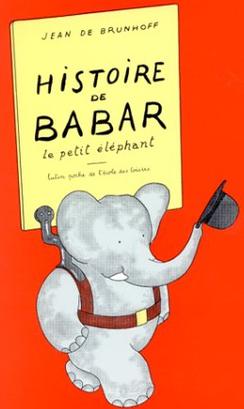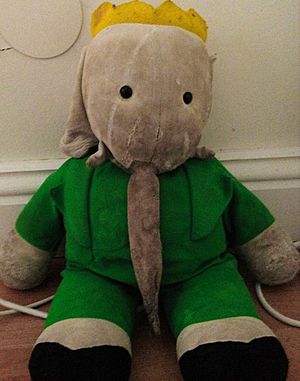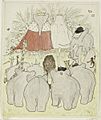Babar the Elephant facts for kids
Quick facts for kids Babar the Elephant |
|
|---|---|

Cover of the first Babar story, Histoire de Babar (Story of Babar), published 1931
|
|
| First appearance | Histoire de Babar, 1931 |
| Created by | Jean de Brunhoff |
| Voiced by | Peter Ustinov Jim Bradford Gordon Pinsent Dan Lett Gavin Magrath (young) Kristin Fairlie (young) Daniel Davies Lee Majors |
| Information | |
| Aliases | Babar, Doctor of Letters, King of the Elephants |
| Species | Elephant |
| Gender | Male |
| Occupation | King |
| Spouse(s) | Celeste |
| Children | Pom, Flora, Alexander, Isabelle |
| Relatives | Arthur (brother-in-law), Badou (grandson), Lulu (granddaughter), Periwinkle (daughter-in-law), Cory (son-in-law) |
| Nationality | African |
| Author | Jean de Brunhoff |
|---|---|
| Country | France |
| Language | French |
| Genre | Children's literature |
| Media type | Print (hardcover and paperback) Audiobook |
Babar the Elephant is a famous elephant character from children's books. He first appeared in 1931 in a French book called Histoire de Babar. This story was created by Jean de Brunhoff.
The idea for Babar came from a bedtime story. Jean de Brunhoff's wife, Cécile, made up the tale for their children. It's about a young elephant named Babar. His mother is lost, and he leaves the jungle.
Babar travels to a big city. There, he learns about human ways and wears clothes. He then returns to his elephant friends. He wants to share the good things he learned from the city. When he gets back, the old elephant king passes away after eating a bad mushroom. Because Babar has seen the world, he is chosen to be the new king. He marries his cousin, Celeste, and they have children. Together, they teach their kids important lessons.
Contents
Babar's Amazing Adventures
Becoming King of the Elephants
After Babar's mother is gone, he runs away from the jungle. He finds himself in a large, busy city. There, a kind Old Lady helps him. She buys him nice clothes and hires a teacher for him.
Later, Babar's cousins, Celeste and Arthur, find him in the city. They help him go back to the Elephant Kingdom. The old King of the Elephants dies after eating a poisonous mushroom. The other elephants remember Babar's travels. They decide he would be a great leader. They say he has "lived among men and learned much." So, Babar is crowned King of the Elephants. He then marries his cousin, Celeste.
Journeys and Challenges
In Jean de Brunhoff's second book, The Travels of Babar, the newly married couple goes on their honeymoon in a balloon. A big storm blows their balloon onto an island. They escape on a whale, but get stuck on an even smaller island! Luckily, a ship rescues them. But then, they are forced to work in a circus.
After escaping the circus, they return home. They find themselves in a conflict with the rhinoceroses. This started when Arthur tied a firecracker to the tail of Lord Rataxes, the rhino leader. Babar wins the conflict with a clever trick. The elephants paint scary faces on their backsides, which frightens the rhinoceroses away. The book ends with Babar, Celeste, and the Old Lady talking. They discuss how Babar can be a wise king and make all the elephants happy.
Building Celesteville
In the third book, Babar the King, Babar decides to build a new city. He names it Celesteville, after his wife. Many dromedaries (camels) help them build the city.
However, building a city isn't always easy. The Old Lady gets bitten by a snake. Also, Cornelius's home catches fire. Babar has a dream where he sees sadness and bad spirits. But then, elephant angels appear. They represent good qualities like Courage and Hope. These angels chase away the bad spirits. This dream helps Babar feel stronger and more hopeful.
Babar's Friends and Family
Babar has many friends and family members who help him. Zephir is a clever monkey. Cornelius is an old, wise elephant advisor. Later, another advisor named Pompadour joins them. Babar's cousin is Arthur.
Babar also has four children: Pom, Flora, Alexander, and a younger daughter named Isabelle. The kind Old Lady who helped Babar in the city comes to live in the Elephant Kingdom. She is treated as an honored guest.
Babar rules his kingdom with a strong hand. He makes all the decisions himself. But he always tries to do what is best for his elephant subjects. He is a kind and fair leader.
Babar also deals with the rhinoceroses, who are led by Lord Rataxes. They live in a nearby country and are often warlike. Much later, in Babar and the Adventures of Badou, Babar's son Pom grows up. Pom becomes the father of Prince Babar II, who is known as Badou.
Babar's Big Impact
Babar is known for wearing a bright green suit. He brings many Western ideas and ways of life to the elephants. Soon, the elephants start wearing clothes too. This focus on stylish clothing might be because the first books were published by a fashion company.
Author Maurice Sendak praised Jean de Brunhoff's work. He said that Brunhoff was a master at creating picture books. He believed that Brunhoff's books changed illustrated books forever.
Babar is very popular around the world. There are over 100 companies that make Babar products. The "Babar" brand is loved by people of all ages. There are even 12 Babar stores in Japan! Babar is as famous as Mickey Mouse as a children's character.
More than 30,000 Babar books have been published in over 17 languages. Over 8 million books have been sold. One popular book is Laurent de Brunhoff's Babar's Yoga for Elephants. It has sold over 100,000 copies in the U.S. The Babar books are even on former First Lady Laura Bush's national reading list.
The Babar TV series is also very popular. All 78 episodes are shown in 30 languages in over 150 countries. This makes Babar one of the most widely shown animated shows ever. Babar has also been a favorite at the White House Easter Egg Roll for many years.
Since 2001, the Babar stories have been owned by Corus Entertainment's Nelvana company. They work with the artist, Clifford Ross.
Babar has even appeared in other stories. In The New Traveller's Almanac, Babar and his elephants help characters travel through the African jungle. In the movie Coming to America, a royal family has a pet elephant named "Babar."
Babar Books
Jean de Brunhoff wrote and drew the first seven Babar books. After he passed away, his son, Laurent de Brunhoff, continued the series.
Here are the first books by Jean de Brunhoff (1931–1941):
- Histoire de Babar (1931) – The Story of Babar
- Le Voyage de Babar (1932) – The Travels of Babar
- Le Roi Babar (1933) – Babar the King
- L'ABC de Babar (1934) – A.B.C. of Babar
- Les vacances de Zéphir (1936) – Zephir's Holidays
- Babar en famille (1938) – Babar and His Children
- Babar et le père Noël (1941) – Babar and Father Christmas
Laurent de Brunhoff has written many more Babar books since 1948. Some of them include:
- Babar et ce coquin d'Arthur (1948) – Babar's Cousin: That Rascal Arthur
- Pique-nique chez Babar (1949) – Babar's Picnic
- Babar au cirque (1952) – Babar at the Circus
- Babar Comes to America (1965)
- Babar's Yoga for Elephants (2006)
- Babar's guide to Paris (2017)
Many English versions of these books are still published today. You can find them individually or in collections.
Babar on Screen
Babar has also starred in many TV shows and movies!
- Les Aventures de Babar (French TV series) (1968)
- The Story of Babar the Little Elephant (1968)
- Babar the Elephant Comes to America (1971)
- Babar and Father Christmas (1986)
- Babar (TV series) (1989–91; 2000)
- Babar: The Movie (1989)
- Babar: King of the Elephants (1999)
- Babar and the Adventures of Badou (TV series) (2010–2015)
Images for kids
-
Marriage and coronation of King Babar and Queen Celeste, The Morgan Library & Museum
See also
 In Spanish: Babar para niños
In Spanish: Babar para niños



